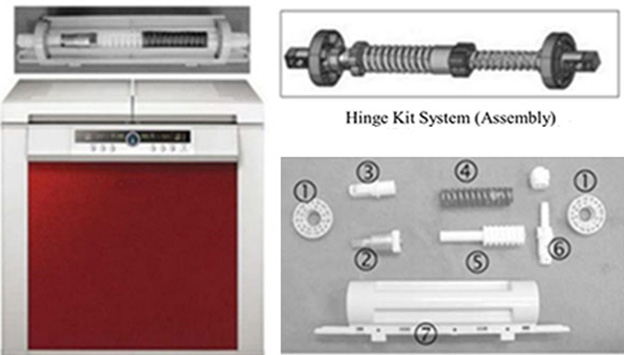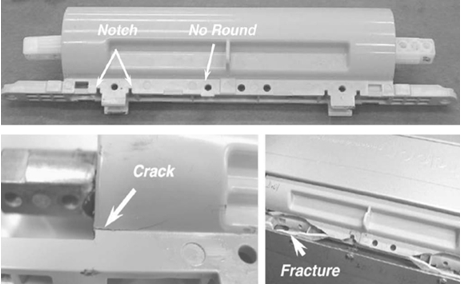Impact Factor : 0.548
- NLM ID: 101723284
- OCoLC: 999826537
- LCCN: 2017202541
Seongwoo Woo1*, Dennis L O Neal2, Yimer Mohammed Hassen1 and Gezae Mebrahtu1
Received: October 04, 2022; Published: October 13, 2022
*Corresponding author: Seongwoo Woo, Ethiopia Manufacturing Technology, Mechanical Technology Faculty, Ethiopian Technical University, Addis Ababa P O Box 190310, Ethiopia
DOI: 10.26717/BJSTR.2022.46.007381
To enhance the fatigue of mechanical product, parametirc accelerated life testing (ALT) as organized reliability way offers to evaluate the design of mechanical products subjected to repeated impact loadings, entrenched on sample size and generalized life–stress model. It helps an engineer to show the design flaws which make a critical influence on product life. Finally, manufactures may circumvent product recalls from the field. As a test case, the redesign of the hinge kit system returned from the marketplace was investigated.
Keywords: Parametric Alt; Mechanical System; Hinge Kit System; Fatigue; Design Defects
The mechanical product such as automobile moves (generated) power to attain a job that involves forces and motion, which produces mechanical advantages by correctly adapting mechanisms. For example, a refrigerator, employing the refrigerating cycle, distributes cooled air from the heat exchanger to each section. When customer wants a gentle door-closing function, hinge kit system is designed. If there is a design imperfection in the HKS where the loads are exerted, it will instantly cease in its anticipated life. As identifying the design imperfections by parametric ALT, a designer might plan the product optimally. This study investigates the para metric ALT as structured reliability way that might be applicable to mechanical systems. It includes:
1. An ALT scheme.
2. A Load inspection.
3. A Customised ALTs with the design modifications, and
4. A Judgement of whether the system attains the targeted BX life.
As a case investigation, we will study the redesign of HKS returned from the marketplace in a domestic refrigerator.
Time independent Schrodinger’s equation in one dimension can be expressed as follows:

where ψn is wave function, En is (electron) energy, h is Planck constant, m is electron mass.
Boundary conditions are:
1) ψn finite inside the metal but decaying exponentially. That is, ψn→0 as x →∞
2) ψn=0 at walls. So, we can find the solution as follows:

where ψn (x+a)=ψn (x), a is (periodic) distance, n is principal quantum number.
Linear transport are defined as follows:
J=LX (3)
Solid-state diffusion of impurities in silicon, J, could be stated as

If Equation (4) puts a reverse function, the life-stress (LS) prototype could be restated as:

The sine hyperbolic form [sinh(aS)]−1 in Equation (3) has attributes as follows:
1) (S)−1 at the starting has some linear outcome,
2) (S)−n has what is formulated as a medium outcome, and
3) (eaS )−1 in the final is high.
As a parametric ALT in the middle scope is performed, Equation (5) could be stated as:

To fulfil the acceleration factor (AF), which might be stated as the ratio between the accelerated stress circumstances and usual operation circumstances, it could be adjusted to integrate with the effort concepts:

To achieve the assigned mission cycle of a parametric ALT, sample size with Equation (7) could be stated as [1]:

Figure 1: Domestic refrigerator and failed HKS returned from the market.
a. Refrigerator
b. HKS components:
• kitcover
• oildamper
• spring
• kit housing.

As the customer require to close door gently, a hinge kit system is added. The main components are kit cover, support, torsional shaft, spring, and HKS housing (Figure 1). In the market, HKS in a domestic refrigerator did not work under unspecified consumer usage circumstances [1]. Market data manifested that the failed part shall have had the design flaws (Figure 2). As manifested in (Figure 3), the mechanical load transfer in a hinge kit system can be modeled as follows:


As the time to failure depended on the impact force due to moment in equations (9) & (10), the life-stress model (LS model) in Equation (6) could be restated as

Thus, the AF in Equation (8) shall be expressed as follows:

Relying on consumer use, the number of openings/closings of the HKS per day varied from 3 to 10 times Under greatest usage for 10 years, the ice dispensing happens about 36,500 usage cycles. Company data states that usual door weight is 1.1 kN and door with an elevated weight is 2.76 kN. Presuming the damage factor, λ, is 2, AF is roughly 6.3 in Equation (12). For B1 life 10 years, assuming the shape parameter was supposed to have 2.0, the assigned mission cycles for six samples calculated from Equation (8) were roughly 23,000 cycles. This parametric ALT is designed to assure a B1 life 10 years if HKS fails less than once in 23,000 cycles.
In the first ALT, the hinge kit system failed at 3000 cycles and 15,000 cycles (Figure 4) manifests a photo contrasting the fractured parts from the market and that from the first ALT. As they are alike, by parametric ALT we could reproduce the hinge kit system returned from the market. There was fragile structure that came from design imperfection. So, to have sufficient strength against repeated loads, the structure of HKS housing was reinforced as follows:
1) The notch was erased and the outside and inside of design was rounded.
2) Strengthened ribs were also attached to the housing and decks (Figure 5).
As disassembling the unsuccessful HKS products, the damper oil leaked at 15,000 cycles. The root cause for this failure arised from the sealing design of oil damper which had embraced an o-ring, Teflon, and o-ring with a space of 0.5 mm. We judged that there could be intrusion between the Teflon and o-ring. To hold the o-ring closely and firmly, the sealing structure was altered as shown in (Figure 6). In the 2nd ALT, the housing cover of hinge kit cover was unsuccessful at 7,800 cycles and 9,200 cycles. As action plan, the material was changed from plastic to aluminium die casting (Figure 7). In the 3rd ALT, there were no issues till 74,000 cycles. During three courses of parametric ALTs with the alternations, the HKS was assured to have B1 life 10 years.
Figure 4: Fractured parts from the marketplace and ALT.
a. Unsuccessful products returned from the field.
b. Failed product after first ALT.

Figure 7: Modified housing cover.
a. Unsuccessful products from the second ALT.
b. Design modifications.



